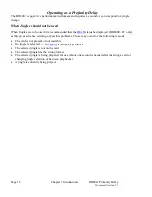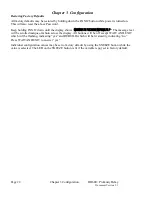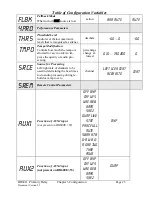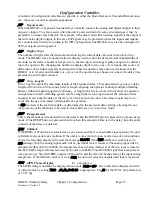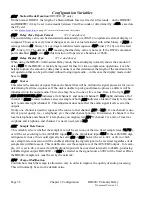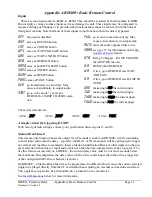
Configuration Variables
Page 32
Chapter 3 Configuration
BD600+ Profanity Delay
Document Version 2.1
SBRK
Station Break Duration (,W only)
On the normal BD600+ the length of a Station Break Insert is fixed at 4.0 seconds – on the
and it may be set to an amount between 2 and 8 seconds or determined by a
JING
le saved on
the CF card.
See
Station Break Insert
on page 35 for more information on this feature.
SEND
Delay Time Export Format
(V1.4 and above)
The current delay value can be transmitted automatically over RS232 to update an external display or
computer. This is sent every time it changes as an ascii value terminated with either binary 0 (
END0
), a
carriage return (
CR -
binary 13) a carriage return/line feed sequence (
CRLF
binary 13,10) or a line feed
(
LF
- binary 10). The default is
OFF
, meaning that the delay value is not sent. If the RS232 command
port is disabled (
BAUD
set to
OFF
) this function will operate at a baud rate of 9600.
SHOW
Delay Display Type
(V1.4 and above)
When using the BD600+ in Broadcast Delay mode, the main display normally shows the amount of
delay
USED
. If the BD600+ is mainly being used for Insert or time-compression operations, it can be
helpful to know the amount of delay that is unused, as this determines the length of the maximum In-
sert operation that can be performed without losing input audio – in this case the display mode could
be set to
FREE
.
SRCE
Source
This selects the amount of signal from each channel that will be fed into the signal processor for use in
determining best time-to-process. If the unit is unable to pick good times-to-process, artifacts will be
introduced into the output audio. This value may be set to one of five values, from left to right,
LEFT
LCEN CENTR RCEN RITE. LEFT
indicates all of channel 1 and none of channel 2.
RITE
(right) indicates all of
channel 2.
CENTR
(center) indicates an even sample of both.
LCEN
indicates a blend of mostly left (chan-
nel 1) and some right (channel 2). This adjustment does not affect the audio signal levels seen at the
outputs.
If only one channel is used for input, set the source to that channel (
LEFT
or
RITE
). If one channel is usu-
ally of poorer quality (i.e., a telephone), give the other channel priority. For instance, if channel 1 is the
local microphone and channel 2 is telephone, you might select
LEFT
. If channel 2 is a mix of local mi-
crophone and telephone, and channel 1 is never used, select
RITE
.
SYNC
Sample Rate Source
This variable selects whether the sample rate will be set to one of the two fixed sample rates (
44.1 48
),
or will be set according to the AES/EBU input
AES
or the Wordclock input
WCLK
. If the AES/EBU digi-
tal inputs are in use, this would typically be set to
AES
or
WCLK
, but can be set to 44.1 or 48, in which
case sample rate conversion will be enabled, allowing the digital signal to be received regardless of its
sample rate (within reason). This variable also sets the sample rate of the AES/EBU output – for exam-
ple, if it is set to 48, a received 44.1kHz digital input will be converted internally to 48kHz, producing
a 48kHz digital output. - if
WNET
is selected as the signal source,
SYNC
will be fixed at
DIG
, as
the BD600+ sample rate must be set by the network.
TMP0
Tempo Modification
Controls how much the tempo is allowed to vary in order to improve the quality of audio processing.
This will normally be set to the default value.
Summary of Contents for BD600+
Page 2: ......

